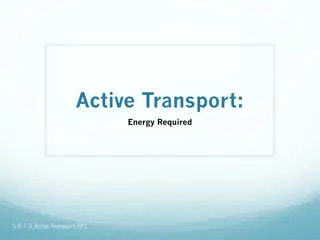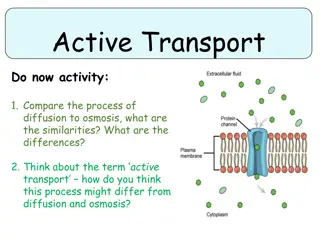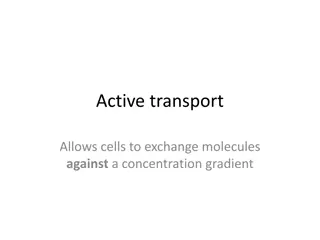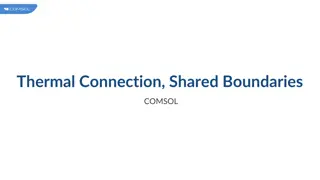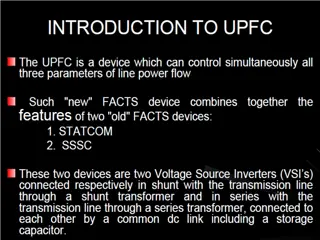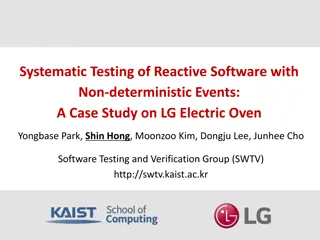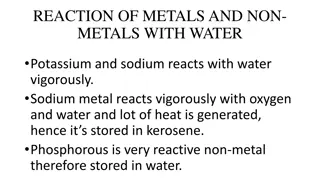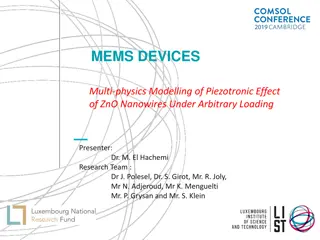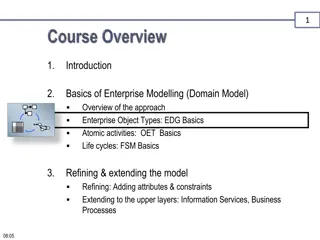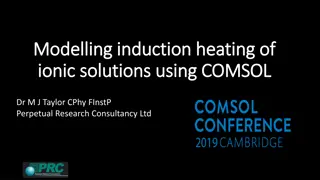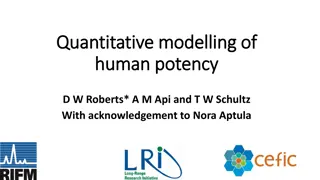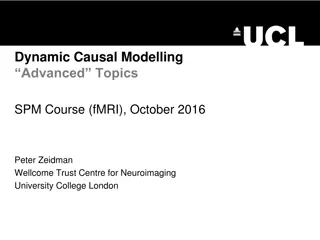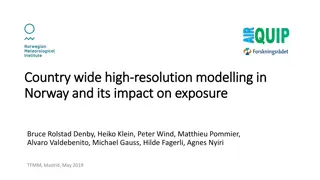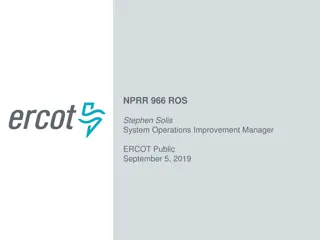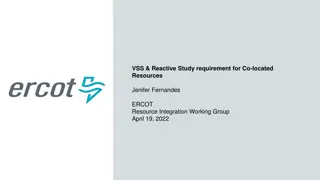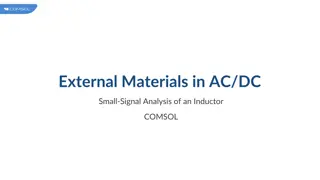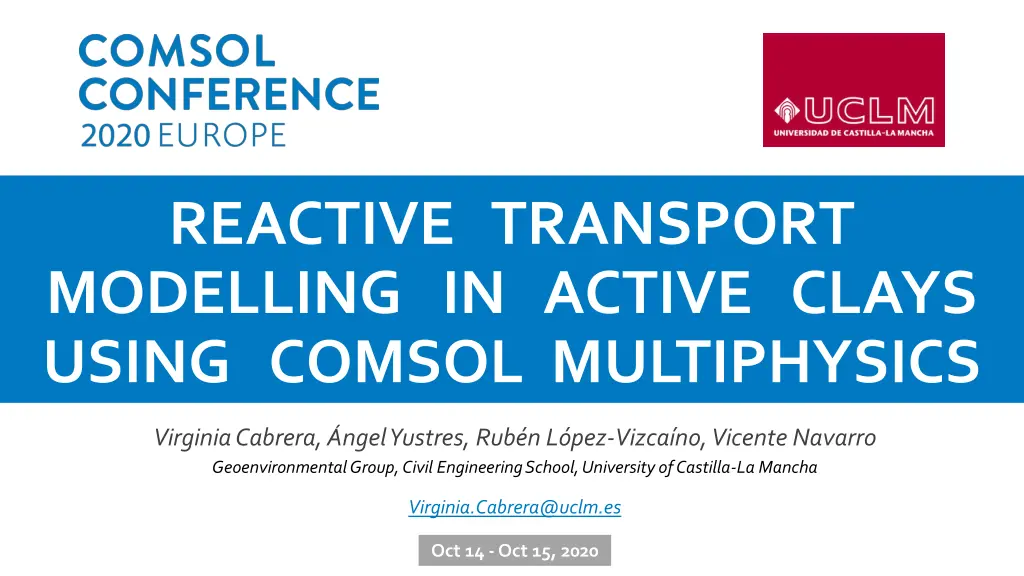
Reactive Transport Modeling in Active Clays
Explore the modeling of solute movement and its interaction with active clays using COMSOL Multiphysics. The study focuses on deep geological disposal, canisters of spent nuclear fuel, bentonite barriers, and molecular structures. Learn about chemical speciation, dissolution-precipitation reactions, micro-macrostructural levels, coupled approaches, and computational efficiency in the context of reactive transport modeling.
Download Presentation

Please find below an Image/Link to download the presentation.
The content on the website is provided AS IS for your information and personal use only. It may not be sold, licensed, or shared on other websites without obtaining consent from the author. If you encounter any issues during the download, it is possible that the publisher has removed the file from their server.
You are allowed to download the files provided on this website for personal or commercial use, subject to the condition that they are used lawfully. All files are the property of their respective owners.
The content on the website is provided AS IS for your information and personal use only. It may not be sold, licensed, or shared on other websites without obtaining consent from the author.
E N D
Presentation Transcript
REACTIVE TRANSPORT MODELLING IN ACTIVE CLAYS USING COMSOL MULTIPHYSICS Virginia Cabrera, ngel Yustres, Rub n L pez-Vizca no, Vicente Navarro GeoenvironmentalGroup, Civil Engineering School, University of Castilla-La Mancha Virginia.Cabrera@uclm.es Oct 14 -Oct 15, 2020
INTRODUCTION GOAL: Understand and simulate the movement of solutes and their interaction with the solid phase of active clays. Deep geological disposal Canister of spent nuclear fuel REACTIVE TRANSPORT MODEL Bentonite barrier Molecular structure of bentonite 2 REACTIVE TRANSPORT MODELLING IN ACTIVE CLAYS USING COMSOL MULTIPHYSICS
REACTIVE TRANSPORT MODEL Chemical speciation in homogeneous liquid phase Dissolution precipitation reactions Geochemical system Micro-Macrostructural levels Donnan equilibrium Structural levels Coupled approach Advection (Darcian flow) Multicomponent diffusive-dispersive transport (Nernst-Planck) High adaptability Transport Easy implementation Computational efficiency 3 REACTIVE TRANSPORT MODELLING IN ACTIVE CLAYS USING COMSOL MULTIPHYSICS
REACTIVE TRANSPORT MODEL Chemical speciation Geochemical system 13 algebraic equations 12 algebraic equations Macrostructural level 10 master species Total concentration of each master species ) ( ) ) M ( ( = + M i M m log log log a K a activity I , eq i im M i M i a = + = M m M i - H molal C c 1 = m Cl M i c im concentration 2+ = Ca Mg H SiO 1 i LLNL model (charged species) [1] Drummond (uncharged species) [2] i activity coefficient M 4 4 3+ 2+ Al 2- 4 + SO K Ionic strength Water activity + - 3 Na HCO 1 2 I H O I = 2 2 M i 1 0.017 = M M i I c z H O a c S i 2 = =1 i 1 i 32 secondary species [1] L.-U.-M.-P. II. University of California. Livermore, California, Lawrence Livermore National Laboratory (1992) S. A. Daveler, and T. J. Wolery, EQPT, A data file preprocessor for the EQ3/6 software package--User s guide and related documentation (Version 7.0). [2] S.E.Drummond, Boiling andmixing of hydrothermal fluids: chemical effects on mineral precipitation, Pennsylvania State University (1981) 4 REACTIVE TRANSPORT MODELLING IN ACTIVE CLAYS USING COMSOL MULTIPHYSICS
REACTIVE TRANSPORT MODEL Chemical speciation Geochemical system 13 algebraic equations 1 algebraic equation Microstructural level 10 master species = + M MCD M clay m MCD m clay Donnan equilibium D Assuming = m i M i + - H Cl DonnanPotential 2+ Ca Mg H SiO z F z F 4 4 = m i M i i RT exp c c D = m i M i i RT exp a a D 3+ 2+ Al 2- 4 + SO K + - 3 Na HCO Electroneutrality condition in microstructural water + = m i 0 z c Q i volumetric charge concentration of clay particles 32 secondary species = s Q CEC n m 5 REACTIVE TRANSPORT MODELLING IN ACTIVE CLAYS USING COMSOL MULTIPHYSICS
REACTIVE TRANSPORT MODEL Kinetics reaction 4 ordinary differential equations Minerals 4 Mass balance of each mineral ) ( M ( ) = m Calcite Gypsum K-Feldspar Quartz M m Ionic Activity Product l g o l o g IAP a IAP K dm min min, m = min = min dt min r = 1 min , s min K Solubility constant , s min Thermoddem [3] Saturation rate Dissolution/Precipitation rate = 1 min r k min s min min Kinetic constant ThermoChimie[4] E E 1 T 1 1 T 1 8. 5 25, R , min a min R = + exp exp k k k a , , min a min a min 25, min 298.15 29 1 [3] waste materials, Applied Geochemistry, 27 (2012) 2107-2116. P. Blanc, A. Lassin, P. Piantone, M. Azaroual, N. Jacquemet, A. Fabbri, E.C. Gaucher, Thermoddem: A geochemical database focused on low temperature water/rock interactions and [4] ThermoChimie, Applied Geochemistry, 49 (2014) 225-236. E. Giffaut, M. Griv , P. Blanc, P. Vieillard, E. Col s, H. Gailhanou, S. Gaboreau, N. Marty, B. Mad , L. Duro, Andra thermodynamic database for performance assessment: 6 REACTIVE TRANSPORT MODELLING IN ACTIVE CLAYS USING COMSOL MULTIPHYSICS
REACTIVE TRANSPORT MODEL Mass balance 10 partial differential equations m + = l 0 m t f m m Sink/source term Total flux Total mass MIN = min,m = + + M m adv M m dif dis m m dif dis f min r l l l l = + m m M m m m m m m m , , , = 1 min Dissolution/ Precipitation rate = M m adv M m M adv l C q = C Sr M m M m M M m Darcian flow Macro Macro , Kinetics reaction I = M m dif di M i j l = m m m C m m m Multicomponent diffusive-dispersive transport (Nernst-Planck) Macro micro im , s = 1 i I = m m i j l micro im , m dif di s = 1 i 7 REACTIVE TRANSPORT MODELLING IN ACTIVE CLAYS USING COMSOL MULTIPHYSICS
REACTIVE TRANSPORT MODEL Mass balance 10 partial differential equations m + = l 0 m t f m m Total flux = + + M m adv M m dif dis m m dif dis l l l l m , , , = M m adv M m M adv l C q Darcian flow Macro , I = M m dif di M i j l Multicomponent diffusive-dispersive transport (Nernst-Planck) Macro im , s = 1 i I = m m i j l micro im , m dif di s = 1 i 8 REACTIVE TRANSPORT MODELLING IN ACTIVE CLAYS USING COMSOL MULTIPHYSICS
REACTIVE TRANSPORT MODEL Mass balance 10 partial differential equations Multicomponent diffusive-dispersive transport Total flux Diffusive-dispersive flux of each i-th species evaluated at L-th functional structural level = + L L L L L adv D Sr D D q e,i o,i dis = + + M m adv M m dif dis m m dif dis l l l l L e i i RT L D c Phenomenological tensor of coefficients m diffusion dispersion , , , , = = L L i L I I l (only in macro) = L i L i L L j ( ) = + + + L i L oi L i L MCD L clay ln RT a z F = Electrochemical potential M m adv M m M adv l C q i Macro , L j L j I z D c RT I ( ) = j M m dif di M i j l L j ln RT a Macro im , L i L i s D c RT ( ) = 1 j = = L i L i j ln 1 RT a z F i i 2 j L j T L j z D c F R I I = m m i j l = micro 1 j im , m dif di s = 1 i 9 REACTIVE TRANSPORT MODELLING IN ACTIVE CLAYS USING COMSOL MULTIPHYSICS
IMPLEMENTATION Equations semi-authomatic implementation in COMSOL with the help of EXCEL Chemical speciation: 13 algebraic equations Kinetics reactions of the minerals: 4 ordinary differential equations Mass balance of components: 10 partial differential equations c_m_ c_m_Cl c_m_H2O c_m_H c_m_Ca c_m_Mg c_m_K c_m_Na c_m_H4SiO4 c_m_Al c_m_SO4 c_m_HCO3 Value a_m_Cl/ac_m_Cl a_m_H2O/ac_m_H2O a_m_H/ac_m_H a_m_Ca/ac_m_Ca a_m_Mg/ac_m_Mg a_m_K/ac_m_K a_m_Na/ac_m_Na a_m_H4SiO4/ac_m_H4SiO4 a_m_Al/ac_m_Al a_m_SO4/ac_m_SO4 a_m_HCO3/ac_m_HCO3 Parameters database 10 REACTIVE TRANSPORT MODELLING IN ACTIVE CLAYS USING COMSOL MULTIPHYSICS
SYNTHETIC CASE OF APPLICATION Multicomponent advective-diffusive-dispersive transport flow- through column experiment in MX-80 compacted bentonite [5] Modelling set up INFLOW SOLUTION Initial porewater in equilibrium with gypsum and calcite INFLOW q = 2.4 m/s OUTFLOW Free flux MX-80 infiltrating fluid concentration (mol kgw-1) 8.498 initial porewater concentration (mol kgw-1) 7.200 pH 2+ Ca Mg 3.50 10-2 5.84 10-2 2+ 2.50 10-2 1.52 10-3 OUTFLOW SOLUTION + K Na Cl 5.00 10-3 2.50 10-4 + 4.64 10-1 9.20 10-2 - 5.01 10-1 2.08 10-1 Isothermal test: 25 C Microporosity: 40.5% Macroporosity: 7.1 % [5] P. Alt-Epping, C. Tournassat, P. Rasouli, C. I. Steefel, K. U. Mayer, A. Jenni, U. M der, S.S. Sengor, R. Fern ndez. Benchmark reactive transport simulations of a column experiment in compacted bentonite with multispecies diffusion and explicit treatment of electrostatic effects, Comput.Geosci.,19 (2015)535-550. H SiO 1.00 10-5 1.00 10-5 4 4 3+ Al SO 1.00 10-5 1.00 10-8 2- 4 4.42 10-2 2.02 10-3 - 3 HCO 7.15 10-5 1.20 10-4 11 REACTIVE TRANSPORT MODELLING IN ACTIVE CLAYS USING COMSOL MULTIPHYSICS
RESULTS Spatial distribution at different observation times of Donnan Potential Spatial distribution at different observation times of pH Spatial distribution at different observation times of gypsum 8.6 -0.026 140 COMSOL Multiphysics t = 0 d t = 0 d (solid line) 8.5 -0.028 120 t = 0 d t = 25 d t = 50 d t = 25 d t = 100 d 8.4 -0.030 100 t = 25 d t = 50 d PHREEQC[6] t = 100 d (markers) CGypsum (mol kg-1) 8.3 -0.032 80 t = 200 d t = 50 d D pH t = 200 d t = 300 d 8.2 -0.034 60 [6] D.L. Parkhurst, C.A.J. Appelo. User s guide to PHREEQ C (Version 2) a computer program speciation, batch-reaction, one-dimensional transport and inverse geochemical calculations, Resources Investigations, Report 99-4259, Denver, Co, USA,(1999) 312. t = 300 d 8.1 -0.036 40 for t = 100 d 8.0 -0.038 20 t = 300 d Water t = 200 d 7.9 0 -0.040 0.00 0.01 0.02 0.03 0.04 0.05 0.00 0.01 0.02 0.03 0.04 0.05 0.00 0.01 0.02 0.03 0.04 0.05 x (m) x (m) x (m) 12 REACTIVE TRANSPORT MODELLING IN ACTIVE CLAYS USING COMSOL MULTIPHYSICS
RESULTS Temporal evolution of the total concentration of main master species in the outflow point Spatial distribution of the concentration of main species in macrostructure at 300 days Spatial distribution of the concentration of main species in microstructure at 300 days 1.E+00 0.06 1.E+01 COMSOL Multiphysics Cl-/10 (solid line) Cl-/10 0.05 Na+/10 1.E+00 Na+/10 1.E-01 SO42- Ca2+ 0.04 PHREEQC[6] Ca2+ Mg2+ Ca2+ 1.E-01 (markers) CM(mol kg-1) Cm(mol kg-1) Cl-/10 CM(mol kg-1) SO42- 1.E-02 0.03 Na+/10 Mg2+ [6] D.L. Parkhurst, C.A.J. Appelo. User s guide to PHREEQ C (Version 2) a computer program speciation, batch-reaction, one-dimensional transport and inverse geochemical calculations, Resources Investigations, Report 99-4259, Denver, Co, USA,(1999) 312. 1.E-02 K+ 0.02 for 1.E-03 K+ SO42- Mg2+ 1.E-03 0.01 Water K+ 1.E-04 0 1.E-04 0 0.01 0.02 0.03 0.04 0.05 0 50 100 150 200 250 300 0 0.01 0.02 0.03 0.04 0.05 x (m) time (days) x (m) 13 REACTIVE TRANSPORT MODELLING IN ACTIVE CLAYS USING COMSOL MULTIPHYSICS
CONCLUSIONS The reactive transport model canbe developed in COMSOL Multiphysics due to its high adaptability, easyimplementationandcomputationalefficiency. Chemical speciation, mass balance and transport give a total of 27 equations that were solved in a coupledapproach. The model developed uses a monolithic approach that greatly reduces the number of time steps required forsimulation. Asaresult, anefficienttooltounderstand andsimulatethebehaviourofbentonite isachieved. 14 REACTIVE TRANSPORT MODELLING IN ACTIVE CLAYS USING COMSOL MULTIPHYSICS
ACKNOWLEDGMENTS Theauthorsacknowledgefunding support from: theMinisteriodeEconom a,Industria yCompetitividadfromSpanishGovernmentand theEuropean Unionthroughthe project [BIA2017- 89287-R(AEI/FEDER,UE)] the Ministerio de Ciencia, Innovaci n y Universidades from Spanish Government through the PostdoctoralGrant[IJC-2018-035212]awardedtoDr.L pez-Vizca no 15 REACTIVE TRANSPORT MODELLING IN ACTIVE CLAYS USING COMSOL MULTIPHYSICS
THANKS FOR YOUR ATTENTION REACTIVE TRANSPORT MODELLING IN ACTIVE CLAYS USING COMSOL MULTIPHYSICS Virginia Cabrera, ngel Yustres, Rub n L pez-Vizca no, Vicente Navarro GeoenvironmentalGroup, Civil Engineering School, University of Castilla-La Mancha Virginia.Cabrera@uclm.es Oct 14 -Oct 15, 2020

